![]()
(le résumé en français se trouve en bas de page)
[ last update: 01.16.2015 ]
The (new) Cadillac Database©
The Cadillac V-16
Series 452C
1933
Part 3
First Generation
Production Records
Return to The (New)
Cadillac Database© Index Page
or to the "V-16" index page
(le résumé en français se trouve en bas de page)
|
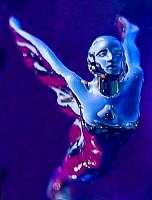
The 1933 V-16 instrument board (right) and "Goddess" (left)
The magnificent, prestige catalog of Cadillac models for 1933 includes on the last page, this statement:
A new policy limits the Cadillac V-16 to four hundred cars for 1933. In the Cadillac V-16, General Motors and the Cadillac Company have given the world the most exalted motor car yet produced. As a medium of transportation, it is not only unsurpassed, but scarcely so much as rivaled... Naturally, such a car can never be destined for more than a relatively few, because of the very ideal involved in its manufacture. Yes the requirements of these few are extremely definite, and it is Cadillac';s conviction that a car should always be built to their purpose... In keeping with this conviction, Cadillac here and now pledges itself to the continued production of such a car, and invites the public to look to Cadillac, year after year, for the world's finest automotive creation... For 1933, Cadillac promises to build for this unusual clientele the sum of four hundred automobiles [they did not quite achieve that production total!]. They will be built on Cadillac';s magnificent 16-cylinder chassis, now carried to even greater heights of performance and mechanical excellence; and under no circumstances will more than this specified number be available within that time. Each car will be a Fleetwood custom creation [though some would be built by Fisher to save on costs]. Each will be serially numbered - ranging from "1" top "400" inclusive - and the owner's name and the serial number will be engraved on a special plate and fixed to the car as an integral part of its composition [my emphasis]... Thus, like a fine home or a beautiful painting or a rare jewel, each car will go through the years a reflection of its owner's personality. And because it is his individual creation, with no relationship to anything else in the world, it will be as ageless, in point of time, as his own character... This, we believe, is the proper conception of a car like the Cadillac V-16 -- for it is decidedly a unique possession, and should obviously go to its owner in a manner bespeaking of it so... The Cadillac Motor Car Company is now prepared to accept and execute commissions for this magnificent car, and early reservations are sincerely advised.
Despite Cadillac's bold assertion, only 126 "Sixteens" were built in 1933, so they are relatively rare. Of these 126 units, research conducted in the sixties and seventies by Carl Steig of the CLC has identified a total of 125 cars; nothing is known of the missing engine, #5000049.
Neverthelss, despite the low production figures, thirty-five different body styles have been listed by Mr. Steig as having been built. Of course, some of these will appear to be duplicates of other styles, the differences being for the most part in the layout of the interior, according to individual buyers' requests.
Each body style is illustrated, below, in ascending order of rarity, the most plentiful styles coming first (the word "plentiful", here, obviously is a misnomer considering that the largest number of any one particular body style was only thirty-two units!)
For the experts out there who are wondering where most of these particular "factory drawings" came from, I should point out that they are modified drawings excerpted from the Fleetwood catalog for 1933. Indeed, for more authenticity I replaced the vertical chevrons on the front fender skirts (as shown in the catalog) with the three horizontal spears featured on the actual production models.
Numbering
One interesting facet of my research into the history and production of sixteen-cylinder Cadillac models is the apparently confusing production and body numbering system. In this regard, the year 1933 is particularly interesting. That year, there were, of course, the consecutive engine/chassis serial number, the Cadillac "Series" number (452-C), the Fleetwood job/style number, the consecutive body unit number and the (apparently consecutive) owner ID or "dash plaque" number. In addition, a (seemingly) consecutive "LX" number was stenciled on the firewall or stamped on a body tag; the lowest "LX" number I have seen mentioned in factory literature is "LX2901" (the latter is identified as a custom 1930 V-16 model).
This illustration of a typical dash plaque for the 1933 Sixteens is featured in a two-tone folder describing car #20
[VIN #5000040?] of that year's production; the caption to the plate reads: Like any limited creation of fine craftsmanship,
each Cadillac V-Sixteen bears a distinctive means of identification. A plate similar to that shown above, engraved with the
individual number of the car and inscribed with the name of the owner is built into the coachwork. I wonder if this one is authentic?
Pre-WW2 Cadillac models with an "X" in the job/style number are "special"; I had a hunch, therefore, that the "LX" cars were "ultra special", possibly approved and personally inspected by Larry Fisher (initial "L"). Later, I came to believe that the "L" designated cars put into livery service (again initial "L") for use by top-notch GM/Cadillac executives.
Now I would like to share with you some thoughts and information on this topic that I got over the last few years from V-16 enthusiast, Carl Stoutenberg. Carl does not share my theory that associates the "LX" numbers with either "L"arry Fisher, or with GM/Cadillac's "L"ivery service, which I recognize was fanciful. He opines, and is probably right, that these numbers may have started with #LX0001, back in the early 1920's. He thinks that #LX2901 [the 1930 custom V-16 mentioned above] is the consecutive number reached in the "LX" group by 1929-1930. Stenciled on the firewall of a custom Madame X job, a Fleetwood #5131 V-16 model built in 1932 R.S. McLaughlin, then President of GM-Canada, is #4200LX; this seems to follow Carl's numerical sequence theory. The "LX" numbers that were used in 1933 again seem to follow the same progression, yet the numbering sequence sometimes appears incongruous [see the table below]. Carl was going to look at later V-16 production records to test his theory. In speaking with another Cadillac aficionado, Karl Nikoloff, I learned that he had a V-12 model from 1932 with the "LX" number 4109. So these numbers were not exclusive to the V-16s.
Carl says :
There is no confusion [in the numbering of these cars]; let me tell you the various numbers of which I am aware on at least one 1933 Cadillac V-16. This is the most thoroughly numbered car I can think of. Others may not have all of these numbers. So, as you hear from other owners for your Database, you might ask them which numbers they have. Be sure that you and they are talking about the same number(s) [and location(s)].
All but the "LX" number appear on the car's build sheet. [On this car - Ser. #5000077] the original owner's name appears on a dash plaque as Theodore W. Case, #117. The serial number (5000077) is a consecutive number assigned to the engine and chassis of the 1933 V-16s; it was used for both title and registration. These numbers are listed on the build sheets, starting with 5000001 and ending with 5000126.
[On the firewall body tag is listed also] Job No 5508 (also called Style number, starting sometime in 1933). The job/style numbers are consecutive for any given body style [i.e. the first body built will carry #1, and so on up to the last such body built]. This particular job [#5508] was a convertible coupe by the Fleetwood Body Co. Only two were built; the Case car carries body #2.
Stenciled on the firewall also is the number "LX5266"; this is the great mystery. So far, I only heard of the number appearing on the cowl, that also carries the body tag listing the job/style number and the body unit number. That "LX" number does not seem to appear on any paper document relating to the specific car. It seems to be a consecutive number and increases as the serial numbers increase [the table, below, shows that theory to be not always true]. The highest number I have seen exceeds the total of all V-8, V-12 and V-16 cars built in 1933. I speculate it might have to do with cars that are customer-ordered as opposed to cars made for inventory.On the original build sheet also is found "SFBO No. 69"; this is the "Special Fleetwood Body Order" number. On this sheet are found the detailed body specifications. It is listed in a box entitled "Fisher Order Number"; it is assumed, therefore, that the same blank form was used for both Fleetwood and Fisher built cars. Not all cars have an SFBO number.
There you have it - seven numbers for a single car. Again not all cars have all seven numbers and the meaning of some of the numbers is unknown to me. Further, there is no explanation why the dash plaque number does not tie directly to the engine number, nor why some dash plaque numbers are higher than the total of 125 V-16 models built in 1933.
Carl Steig is an authority and possibly has knowledge of some of this, however, we are really digging deep into the trivial pursuit aspect of numbering and this may not have been studied in the detail we may wish it might have been.
Note too the above applies to 1933 only. I do not know at this time if similar numbering exists on earlier or later years and leave that to other scholars to unveil.Below is a list of VINs for which an "LX" number has been found (as Carl has explained, there is apparently no way to check "LX" numbers against factory build sheets to determine authenticity). If Carl's theory (which I now share) is correct then the "LX" numbers for some of these sixteens must be incorrect, since they do not follow the same ascending numerical sequence as chassis/engine numbers. My gut feeling is that the "LX" numbers need not be in sequence with the VIN. More likely they were stenciled on the firewall in the order the cars were built, which is not necessarily the order in which the chassis rolled off the production line.
I added a few of these "LX" numbers in March 2009, thanks to data I got from 1933 V-16 owner-enthusiast Rick LeForge. Rick kindly provided me with the bulk of his original V-16 research material from his personal archives, some of it dating back as far as the early fifties! Among that historic material are a host of "fingerprints" of body tags from surviving cars (or parts of cars) as proof-positive of their existence. These "fingerprints" were taken by Rick by pressing a white card onto the car's body tag and then rubbing over the surface with a soft lead pencil (a useful technique that preceded the current use of pocket-sized digital cameras!). An example of a "fingerprint" card is shown below.
I have informed Rick that as soon as I have processed the data and incorporated it in the Cadillac Database, I will commit the originals to the Museum and Research Center of the Cadillac & LaSalle Club, Inc., for safe-keeping.
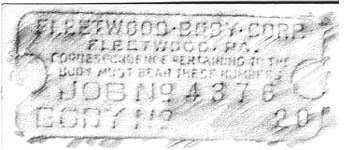
Photo of body tag (right) is from a surviving 1933 V-16 model (its "LX" # listed below)
Chassis # (in or out of sequence) "LX" # (in sequence) Comment ? 2901 1930-31 Fisher 7p V-16 sedan ? 2905 1930-31 Fisher 5p V-16 town sedan ? 2913 1930-31 Fisher 5p V-16 coupe ? 4109 1932 Special V-12 model [NOT a V16] 5000028 4571 VIN Out of sequence 5000043 4572 VIN Out of sequence 5000082 4710 [re-body car, so unreliable Nos.] 5000024 5092 5000097 5138 VIN Out of sequence 5000031 5141 VIN Out of sequence 5000066 5194 VIN Out of sequence [info from Chris Cummings] 5000045 5195 VIN Out of sequence ? 5253 1933 Special V-8 model 5000077 5266 4000324 5268 1933 V-12 sedan model ("212") with limo body tag ("213") 5000088 5270 5000101 5435 5000102 5441 5000095 5506 VIN Out of sequence 5000116 5514
In addition to VIN and "LX" numbers and according to Cadillac's own statement, above, each car delivered carried a dash plaque (individual ID plate) honoring the owner. I have only ever seen one of them on a car (the convertible sedan built for singer-showman, Al Jolson). Mounted on the wood fascia in the center of the dash, the plate carries a number, which appears to be the last digits of the VIN.
|
|
The table below summarizes vee-sixteen production for 1933; the models are listed in order of rarity. Some job/style numbers were copied from a factory publication entitled "Chart of Body Types, Style or Job Numbers and Wheelbase", provided kindly by Rick LeForge; some of these appear on that listing followed by "(Fl.)" indicating that they were built by Fleetwood, presumably from a standard Fisher design.
Production numbers were researched in the 60s by CLC member, Carl Steig. The results of Carl's research appear in the tables below. Entries in italics are from the "Chart" mentioned above. Carl mentions few of them in his analysis.
There have been a few survivors. Click here to view them.
Production numbers of the 1933
Cadillac V-16
[in ascending order of rarity]
| Style Number | Body Type | Units Built | Notes |
Fleetwood bodies [149" wheel base V-16 chassis]
|
|||
| 5575 | 7-pass limousine | 32 | Body #1-32 |
| 5575S | 7-pass sedan | 21 | Body #1-21 |
| 5579 | 5-pass all-weather phaeton | 8 | Body #1-8 |
| 5533S | 5-pass. club sedan | 6 | Body #1-6 |
| 5565 | 7-pass. "Madame X" limousine | 4 | Body #2-51 |
| 5581 | 5-pass. town coupe | 4 | Body #1-4 |
| 5591 | 7-pass. limousine brougham | 4 | Body #1-4 |
| 5525 | 7-pass. town car | 3 | Body #1-3 |
| 5530S | 5-pass. sedan | 3 | Body #1-3 |
| 5531 | 5-pass. "Madame X" limousine | 3 | Body #3, 6, 72 |
| 5575FL | 7-pass. limousine with leather roof covering and no quarter windows | 3 | Body #1-3 |
| 5540 | 5-pass. limousine with leather roof covering and no quarter windows | 2 | Body #1-2 |
| 5540S | 5-pass. sedan with leather roof covering and no quarter windows | 2 | Body #1-2 |
| 5555 | 5-pass. "Madame X" limousine with leather roof covering and no quarter windows | 2 | Body #3, 43 |
| 5573 | 7-pass. limousine | 2 | Body #1-2 |
| 5576 | 2-pass. coupe with golf doors either side | 2 | Body #1-2 |
| 5585 | 5-pass. convertible coupe (Victoria) | 2 | Body #9, 104 |
Sub-Total [this group] |
103 | ||
Fleetwood bodies [143" wheel base V-16 chassis]
|
|||
| 5508 | 2-pass convertible coupe | 4 | Body #1-4 |
| 5509 | 2-pass. coupe | 2 | Body #1-2 |
Sub-Total [this group] |
6 | ||
Unique Fisher bodies [143" wheel base V-16 chassis]
|
|||
| 155 | 2-pass roadster | 0 | although it appears on the factory's Job/Style listing |
| 178 | 2-pass. coupe | 0 | although it appears on the factory's Job/Style listing |
| 168 | 2-pass convertible coupe | 1 | #8 [owned/restored by Dick Shappy - 6/2005] |
| 272 | 5-pass. coupe | 1 | |
Sub-Total [this group] |
2 | ||
Unique Fisher Styles but built by Fleetwood (?) [149" wheel base V-16 chassis] (from factory published "Chart of Body Types, Style or Job Numbers and Wheelbase")
|
|||
| 209 | 5-pass. sedan [Fleetwood #5130-S?] | ? | included on the factory's Job/Style listing |
| 212 | 7-pass. sedan [Fleetwood #5175-S?] | ? | included on the factory's Job/Style listing |
| 213 | 7-pass. imperial sedan [Fleetwood #5175?] | ? | included on the factory's Job/Style listing |
| 225 | 5-pass. town car [Fleetwood #5512?] | ? | included on the factory's Job/Style listing |
| 226 | 7-pass. town car, metal back [Fleetwood #5191?] | ? | included on the factory's Job/Style listing |
| 227 | 7-pass. town car, leather back [Fleetwood #5125?] | ? | included on the factory's Job/Style listing |
| 256 | 5-pass. phaeton | ? | included on the factory's Job/Style listing |
| 273 | 5-pass. all-weather phaeton | ? | included on the factory's Job/Style listing |
| 5512 | 5-pass. town car | 1 | Body #1 |
| 5520 | 5-pass. town car | 1 | Body #1 |
| 5524 | 7-pass. town car | 1 | Body #1 |
| 5530 | 5-pass. limousine | 1 | Body #1 |
| 5530FL | 5-pass limousine with leather roof covering and no quarter windows | 1 | Body #145 |
| 5530H4 | 5-pass. limousine (4" more headroom) | 1 | Body #1 |
| 5531S | 5-pass. "Madame X" sedan | 1 | Body #1 |
| 5555C | 5-pass. "Madame X" limousine landaulet | 1 | Body #1 |
| 5559 | 5-pass. sport phaeton with dual cowl | 1 | Body #1 |
| 5561S | 5-pass. close-coupled sedan | 1 | Body #26 |
| 5574 | 7-pass. limousine with leather roof covering and no quarter windows | 1 | Body #1 |
| 5579A | 5-pass. all-weather phaeton, with trunk | 1 | Body #1 |
| 5583 | 2-pass. special coupe (chrome radiator shell) | 1 | Body #1 |
| 5599 | 5-pass. aerodynamic coupe | 1 | Body #1 |
Sub-Total [this group] |
14 | ||
Sub-Total [cars only] |
125 | ||
Unknown Engine Number
|
|||
| ? | 5000049 [may have been used as a show chassis] | 1 | may never have received a body |
|
126 | 7 | |
1 Body #1 (and possibly others too) may have been mounted on V-8 or V-12 chassis in 1932 or 1933
2 Bodies #1, 2, 4 and 5 (and possibly others too) may have been mounted on V-8 or V-12 chassis in 1932 or 1933
3 Bodies #1 and 2 (and possibly others too) may have been mounted on V-8 or V-12 chassis in 1932 or 1933
4 Bodies #1 through 8 (and possibly others too) may have been mounted on V-8 or V-12 chassis in 1932 or 1933
5 The same body numbers were used also in 1932; bodies #1, 3, 4 and 5 were mounted on the 1932 V-12 chassis; bodies #2 and 7were mounted
on the 1932 V-16 chassis; bodies #8, 9, 10, 11, 12, 13 and 15 were mounted on the V-12 chassis for 1933
6 Body #1 (and possibly others too) may have been mounted on V-8 or V-12 chassis in 1932 or 1933
7 The Cadillac Master Parts List usually lists only body styles actually built. For 1933, however, the list includes the
following styles, although none of them appear to have been built on the V-16 chassis: #s 5502, 5513, 5514, 5521, 5526,
5532, 5532-S, 5533, 5535, 5536, 5545, 5545-S, 5550, 5557, 5558, 5560, 5561, 5563, 5563-S, 5564, 5564-B, 5565-S,
5566, 5566-S, 5573-S, 5574-S, 5575-SFL, 5577, 5578, 5580, 5586, 5590 and 5592.
Some factory and catalog photos
|
The Unique Sixteens for 1933
Unique Styles by Fisher
[ image missing ? ] Style #33-16-272 [based on Fisher style numbering, logically a coupe with metal back]
|
Unique Styles by Fleetwood
Style #5512
Fleetwood style #5512, town car for five passengers (only 1 unit built)
Style #5520
Fleetwood style #5520, town car for seven passengers (only 1 unit built)
Style #5524
Fleetwood style #5524, town car for seven passengers (only 1 unit built)
Style #5530
Fleetwood style #5530, sedan for five passengers (only 1 unit built)
[this is basically the same style as 5530S, above but includes a partition and division
glass between the front and rear compartments, as well as a pair of light opera seats]
Style #5530-FL
Fleetwood style #5530FL, formal sedan [F] for five passengers (only 1 unit was built on the V-16 chassis);
this style is similar to style 5530 (above) but features a leather roof covering [L] and enclosed rear quarters;
it was bought new by Frederick William Vanderbilt, grandson of Cornelius, the railroad mogul; the car survives
Style #5530-H4
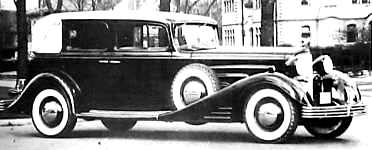
Fleetwood style #5530H4, limousine for five passengers (only 1 unit built)
This style too is similar to style 5530, above, but headroom [H] was increased by 4" [4]
[the factory photo (left) is believed to depict that car picture here is of the "standard' style 5530]
Style #5531-S
Fleetwood style #5531S, "Madame X" sedan for five passengers (only 1 unit built)
[this is basically the same style as 5531, above, but there is no partition nor division
glass between the front and rear compartments, nor any auxiliary seating]
Style #5555-C
Fleetwood style #5555C, "Madame X" landaulet sedan for five passengers (only 1 unit built)
[this is basically the same style as 5555, above, but with an
opening roof portion over the rear passenger compartment]
Style #5559
Look at the fat wheels and tires on the preceding image, as well as the bumpers and the "ground marks"
around the front and rear wheels: it looks very much like a B&W rendering of this, yellow & brown version;
however, neither appear to have the distinctive character of the original Fleetwood catalog drawing (below);
the "red light" above the tear-drop tail-light (below it) is actually the number plate and its stanchion
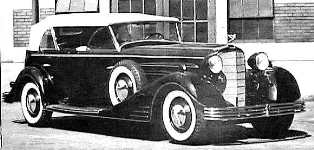
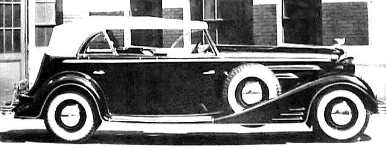
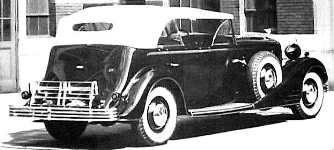
Fleetwood style #5559, dual-cowl, sport phaeton for five passengers (only 1 unit built)
This car, in my opinion, is the most stylish of all the vee-sixteens from 1930-1940
Style #5561-S
Fleetwood style #5561S, close-coupled sedan for five passengers (only 1 unit built)
Style #5574
Fleetwood style #5574, limousine for seven passengers (only 1 unit built)
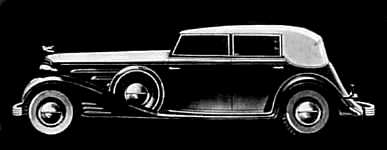
Fleetwood style #5579A, special convertible sedan for five passengers (only 1 unit built - it has survived, right)
Fundamentally, this is the same as style #5579 (above), with the addition of an integral trunk
Style #5575FL (?)
[ possibly a survivor ...with a weak rear door handle spring? ]
Style #5583
Fleetwood style #5583, special coupe for two passengers (only 1 unit built);
there is no drawing of it in that year's Fleetwood catalog; my guess is that it was
a slightly modified version of style #5576; it is said to have had a chrome-plated
radiator shell, where paint was standard that year]
Style #5599

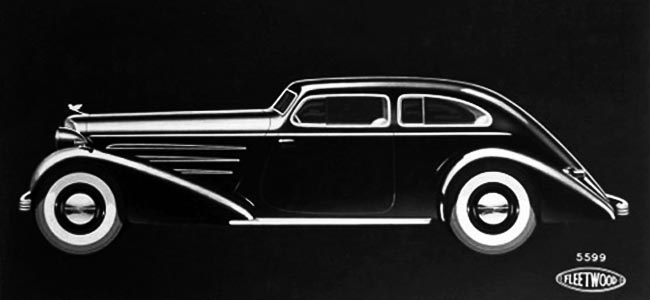
The light playing on the rear wheel of the car in this original factory designer's drawing makes the wheel appear out of proportion
Clay buck under preparation
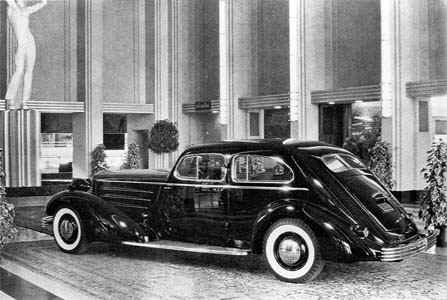
The new aero coupe was on show in the
entrance hall of the Cadillac pavilion
This original factory photo has had the background colored in
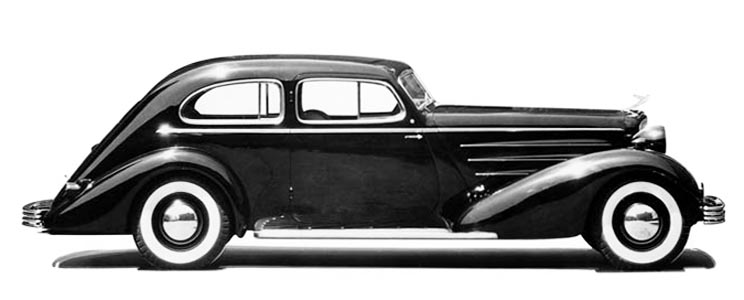
Fleetwood style #5599, special aerodynamic coupe for five passengers (only 1 unit built)
[this car was built for the Chicago World's Fair, A Century of Progress]
Unique Styles from Domestic
Coach Builders
|
Catalog proposals that never saw production
|
|
Return to The (New)
Cadillac Database© Index Page
or to the "V-16" index page
© 1996, Yann
Saunders and the Cadillac-LaSalle Club, Inc.
[ Background image: the powerful frontal image of the Sixteens for 1933;
full-width, four-bar bumpers are immediate clue to car's ID ]